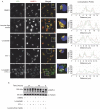Aborted autophagy and nonapoptotic death induced by farnesyl transferase inhibitor and lovastatin
- PMID: 21228063
- PMCID: PMC3063739
- DOI: 10.1124/jpet.110.174573
Aborted autophagy and nonapoptotic death induced by farnesyl transferase inhibitor and lovastatin
Abstract
Exposure of the human malignant peripheral nerve sheath tumor cell lines STS-26T, ST88-14, and NF90-8 to nanomolar concentrations of both lovastatin and farnesyl transferase inhibitor (FTI)-1 but not to either drug alone induced cell death. ST88-14 and NF90-8 cells underwent apoptosis, yet dying STS-26T cells did not. FTI-1 cotreatment induced a strong and sustained autophagic response as indicated by analyses of microtubule-associated protein-1 light chain 3 (LC3)-II accumulation in STS-26T cultures. Extensive colocalization of LC3-positive punctate spots was observed with both lysosome-associated membrane protein (LAMP)-1 and LAMP-2 (markers of late endosomes/lysosomes) in solvent or FTI-1 or lovastatin-treated STS-26T cultures but very little colocalization in lovastatin/FTI-1-cotreated cultures. The absence of colocalization in the cotreatment protocol correlated with loss of LAMP-2 expression. Autophagic flux studies indicated that lovastatin/FTI-1 cotreatment inhibited the completion of the autophagic program. In contrast, rapamycin induced an autophagic response that was associated with cytostasis but maintenance of viability. These studies indicate that cotreatment of STS-26T cells with lovastatin and FTI-1 induces an abortive autophagic program and nonapoptotic cell death.
Figures







References
-
- Adjei AA. (2005) Farnesyltransferase inhibitors. Cancer Chemother Biol Response Modif 22:123–133 - PubMed
-
- Araki M, Motojima K. (2008) Hydrophobic statins induce autophagy in cultured human rhabdomyosarcoma cells. Biochem Biophys Res Commun 367:462–467 - PubMed
-
- Basso AD, Mirza A, Liu G, Long BJ, Bishop WR, Kirschmeier P. (2005) The farnesyl transferase inhibitor (FTI) SCH66336 (lonafarnib) inhibits Rheb farnesylation and mTOR signaling. Role in FTI enhancement of taxane and tamoxifen anti-tumor activity. J Biol Chem 280:31101–31108 - PubMed
-
- Berg TO, Fengsrud M, Strømhaug PE, Berg T, Seglen PO. (1998) Isolation and characterization of rat liver amphisomes. Evidence for fusion of autophagosomes with both early and late endosomes. J Biol Chem 273:21883–21892 - PubMed
Publication types
MeSH terms
Substances
Grants and funding
LinkOut - more resources
Full Text Sources
Research Materials
Miscellaneous

